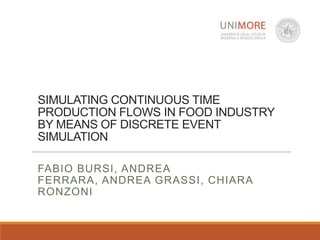SIMULATING CONTINUOUS TIME PRODUCTION FLOWS IN FOOD INDUSTRY BY MEANS OF DISCRETE EVENT SIMULATION
- 1. SIMULATING CONTINUOUS TIME PRODUCTION FLOWS IN FOOD INDUSTRY BY MEANS OF DISCRETE EVENT SIMULATION FABIO BURSI, ANDREA FERRARA, ANDREA GRASSI, CHIARA RONZONI
- 2. 10/8/2013 FABIO BURSI - THE 10┬░ INTERNATIONAL MULTIDISCIPLINARY MODELING & SIMULATION MULTICONFERENCE 2 Outline 1. Context, Aim and Core; 2. Simulation Units: Base Unit; 3. The Base Unit Model; 4. Additional Parameters; 5. The Base Unit Model: Schema; 6. In-depth Description of two objects: a) Failures and repairs object; b) Working speed and accumulation object.
- 3. 10/8/2013 FABIO BURSI - THE 10┬░ INTERNATIONAL MULTIDISCIPLINARY MODELING & SIMULATION MULTICONFERENCE 3 Context, Aim and Core Context ŌŚ” Continuous flow processes: food and beverages industry; ŌŚ” Automated high speed lines: automated packaging lines; Aim ŌŚ” New modelling framework that aims to reproduce the behavior of a continuous time stochastic process; Core ŌŚ” Define a generalized model able to represent a continuous time process by using a discrete event approach, in which the events are signals related to the changes of state of the simulation units.
- 4. 10/8/2013 FABIO BURSI - THE 10┬░ INTERNATIONAL MULTIDISCIPLINARY MODELING & SIMULATION MULTICONFERENCE 4 Simulation Units: Base Unit All simulation units can be modelled by a generalized base unit able to represent the main categories of working units found in real applications, such as: ŌŚ” Work centres continuously operating on the flow; ŌŚ” Buffers; ŌŚ” Conveying units. Performance measures: ŌŚ” Throughput; ŌŚ” Efficiency; ŌŚ” Stay time in different status; ŌŚ” ŌĆ”
- 5. 10/8/2013 FABIO BURSI - THE 10┬░ INTERNATIONAL MULTIDISCIPLINARY MODELING & SIMULATION MULTICONFERENCE 5 The Base Unit Model The base unit model behaviours are: ŌŚ” Failures and repairs (FR): ŌŚ” represents the operational state of the unit and is related to the Time-To-Failure (TTF) and the Time-To-Repair (TTR) profiles. ŌŚ” Working speed and accumulation (WSA): ŌŚ” makes possible, on one hand, to model the variation in working speed as a consequence of state changes in the upstream or in the downstream flow and, on the other hand, to model the variation in internal accumulation level. ŌŚ” Throughput time (T): ŌŚ” represents a delay that has to be applied to a signal exiting from the considered unit.
- 6. 10/8/2013 FABIO BURSI - THE 10┬░ INTERNATIONAL MULTIDISCIPLINARY MODELING & SIMULATION MULTICONFERENCE 6 Additional Parameters The proposed modelling approach provides the capability to include additional parameters: ŌŚ” Temperature of the product; ŌŚ” Concentration of pollutant substances; ŌŚ” ŌĆ” In food industry, it is critical to trace this kind of parameters because they are related to the process control policies and the product traceability strategies, as well as product waste and net efficiency estimation.
- 7. 10/8/2013 FABIO BURSI - THE 10┬░ INTERNATIONAL MULTIDISCIPLINARY MODELING & SIMULATION MULTICONFERENCE 7 The Base Unit Model: Schema The base unit model is composed by: ŌŚ” Failures and repairs (FR); ŌŚ” Working speed and accumulation (WSA); ŌŚ” Throughput time (T); ŌŚ” N additional parameter models (PARAMk); ŌŚ” Interface (I).Input Signal: {flow parameter, actual working speed, n additional parameter functions}
- 8. 10/8/2013 FABIO BURSI - THE 10┬░ INTERNATIONAL MULTIDISCIPLINARY MODELING & SIMULATION MULTICONFERENCE 8 Failures and Repairs Object Model ŌĆó Entering state: up; ŌĆó Two different cases can be found: 1. A working speed change signal comes from the WSA object (operation dependent); States: up ŌĆō set ŌĆō up; 2. An internal state change happens; States: up ŌĆō down ŌĆō set ŌĆō up;
- 9. 10/8/2013 FABIO BURSI - THE 10┬░ INTERNATIONAL MULTIDISCIPLINARY MODELING & SIMULATION MULTICONFERENCE 9 Working speed and accumulation object model 1. Entering state: init; 2. Wait ŌĆō update: signal from FR object (state up); 3. Wait ŌĆō update: arrives a external signal; 4. Wait ŌĆō boundary: when a boundary state is reached; 5. Wait ŌĆō update: signal from FR object (state down);
- 10. 10/8/2013 FABIO BURSI - THE 10┬░ INTERNATIONAL MULTIDISCIPLINARY MODELING & SIMULATION MULTICONFERENCE 10 Conclusions and Future Development Conclusions: ŌŚ” The proposed approach: ŌŚ” Allows to save computation time; ŌŚ” Avoids the need to model all production flow; ŌŚ” Ensures the accurate behaviour of the system; ŌŚ” The base unit model is suitable for all industrial plants. Future Development: ŌŚ” To extend the proposed model with control policies of the considered machines of the production system.
- 11. 10/8/2013 FABIO BURSI - THE 10┬░ INTERNATIONAL MULTIDISCIPLINARY MODELING & SIMULATION MULTICONFERENCE 11 ŌĆ”Thanks for your kind attention











